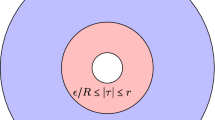Abstract
In a new algebro-geometric way we completely determine whether smooth del Pezzo surfaces are K-(semi)stable or not.
In the present article, all varieties are defined over an algebraically closed field k of characteristic 0.

Similar content being viewed by others
References
Blum, H., Jonsson, M.: Thresholds, valuations, and K-stability. arXiv:1706.04548
Cheltsov, I.: Log canonical thresholds of del Pezzo surfaces. Geom. Funct. Anal. 11, 1118–1144 (2008)
Cheltsov, I., Park, J.: Global log-canonical thresholds and generalized Eckardt points. Sb. Math. 193(5–6), 779–789 (2002)
Cheltsov, I., Park, J.: Sextic double solids. In: Bogomolov, F., Tschinkel, Yu. (eds.) Cohomological and geometric approaches to rationality problems, Progr. Math., vol. 282, pp. 75–132. Birkhäuser, Boston (2010)
Cheltsov, I., Park, J., Won, J.: Log canonical thresholds of certain Fano hypersurfaces. Math. Z. 276(1–2), 51–79 (2014)
Cheltsov, I., Shramov, K.: Log-canonical thresholds for nonsingular Fano threefolds. With an appendix by J.-P. Demailly. Russ. Math. Surv. 63(5), 859–958 (2008)
Chen, X., Donaldson, S., Sun, S.: Kähler–Einstein metrics on Fano manifolds I: approximation of metrics with cone singularities. J. Am. Math. Soc. 28(1), 183–197 (2015)
Chen, X., Donaldson, S., Sun, S.: Kähler–Einstein metrics on Fano manifolds, II: limits with cone angle less than \(2\pi \). J. Am. Math. Soc. 28(1), 199–234 (2015)
Chen, X., Donaldson, S., Sun, S.: Kähler–Einstein metrics on Fano manifolds III: limits as cone angle approaches \(2\pi \) and completion of the main proof. J. Am. Math. Soc. 28(1), 235–278 (2015)
Fujita, K.: On K-stability and the volume functions of \(\mathbb{Q}\)-Fano varieties. Proc. Lond. Math. Soc. 113(5), 541–582 (2016)
Fujita, K.: K-stability of Fano manifolds with not small alpha invariants. To appear in J. Inst. Math. Jussieu. doi:10.1017/S1474748017000111
Fujita, K.: On Berman–Gibbs stability and K-stability of \(\mathbb{Q}\)-Fano varieties. Compositio Math. 152, 288–298 (2016)
Fujita, K., Odaka, Yu.: On the K-stability of Fano varieties and anticanonical divisors. To appear in Tohoku Math. J. arXiv:1602.01305
Hacking, P., Prokhorov, Yu.: Smoothable del Pezzo surfaces with quotient singularities. Compositio Math. 146(1), 169–192 (2010)
Hwang, J.-M., Kim, H., Lee, Y., Park, J.: Slopes of smooth curves on Fano manifolds. Bull. Lond. Math. Soc. 43(5), 827–839 (2011)
Kempf, G.: Instability in invariant theory. Ann. Math. (2) 108(2), 299–316 (1978)
Kollár, J.: Singularities of pairs. In: Kollr, J., Lazarsfeld, R., Morrison, D. (eds.) Algebraic geometry (Santa Cruz, 1995) Part 1, Proc. Sympos. Pure Math., vol. 62, pp. 221–287. Amer. Math. Soc. (1997)
Manetti, M.: Normal degenerations of the complex projective plane. J. Reine Angew. Math. 419, 89–118 (1991)
Manetti, M.: Normal projective surfaces with \(\rho =1\), \(P_{-1}\ge 5\). Rend. Sem. Mat. Univ. Padova 89, 195–205 (1993)
Odaka, Yu., Sano, Yu.: Alpha invariant and K-stability of \(\mathbb{Q}\)-Fano varieties. Adv. Math. 229(5), 2818–2834 (2012)
Odaka, Yu., Spotti, C., Sun, S.: Compact moduli spaces of del Pezzo surfaces and Kähler–Einstein metrics. J. Differ. Geom. 102(1), 127–172 (2016)
Panov, D., Ross, J.: Slope stability and exceptional divisors of high genus. Math. Ann. 343(1), 79–101 (2009)
Prokhorov, Yu.: A note on degenerations of del Pezzo surfaces. Ann. Inst. Fourier (Grenoble) 65(1), 369–388 (2015)
Ross, J., Thomas, R.: A study of the Hilbert–Mumford criterion for the stability of projective varieties. J. Algebraic Geom. 16(2), 201–255 (2007)
Tian, G.: On Kähler–Einstein metrics on certain Kähler manifolds with \(c_1(M)>0\). Invent. Math. 89, 225–246 (1987)
Tian, G.: K-stability and Kähler–Einstein metrics. Commun. Pure Appl. Math. 68 (7), 1085–1156 (2015). [Corrigendum: K-Stability and Kähler–Einstein Metrics. 68 (11), 2082–2083 (2015)]
Author information
Authors and Affiliations
Corresponding author
Additional information
Appendix
Appendix
In Appendix Lemmas 4.1, 4.2 and 4.3 are verified. All the notations are the same as those in the beginning of Sect. 4.
We consider the vector space
with an ordered basis \(\{x^\alpha y^\beta \ | \ \alpha +\beta \le \lambda \}\), where \(k[x,y]_n\) is the \((n+1)\)-dimensional vector space of homogeneous polynomials of degree n in variables x, y. The order of the basis is given in the following way:
-
(1)
the graded lexicographic order with \(x\prec y\) except for Case 2 in Theorem 4.4 and Case 2 in Theorem 4.8;
-
(2)
the graded lexicographic order with \(y\prec x\) for Case 2 in Theorem 4.8;
-
(3)
the order for Case 2 in Theorem 4.4 satisfies the properties:
-
(a)
\(x^{\alpha _1} y^{\beta _1}\prec x^{\alpha _2} y^{\beta _2}\) if \(\alpha _1+\beta _1<\alpha _2+\beta _2\);
-
(b)
\(x^{\alpha } y^{\alpha }\prec x^{\alpha _2} y^{\beta _2}\) if \(\alpha _2\ne \beta _2\) and \(\alpha _2+\beta _2=2\alpha \).
-
(a)
Note that these orders make the monomial \(\prod _{i=1}^{d+1} \mathbf {x}_{1,i}^{n_i}\) in \(\mathcal {C}_m\) smaller than any other monomials that appear in \(\prod _{i=1}^{d+1} t_i^{n_i}\).
Since \(f_{m, i}\) is a member of the vector space \(V_{3m}\), we may express the polynomial \(f_{m, i}\) as a \(1\times \sigma \) matrix with respect to the given ordered basis, where \(\sigma =\frac{(3m+1)(3m+2)}{2}\). By writing these \(1\times \sigma \) matrices as rows, we can express the \(\ell _m\) polynomials \(f_{m,1},\cdots , f_{m,\ell _m}\) altogether as a single \(\ell _m\times \sigma \) matrix \(M_F\). Since \(f_{m,1},\cdots , f_{m,\ell _m}\) are linearly independent, the rank of the matrix \(M_F\) is exactly \(\ell _m\).
Let E be a row echelon form of the matrix \(M_F\). Then there is an \(\ell _m\times \ell _m\) invertible matrix T such that \(M_F=TE\). Since the rank of \(M_F\) is \(\ell _m\), the matrix E does not have any zero row. The i-th row of E represents a polynomial \(h_{m,i}\) that belongs to \(\mathcal {L}_m\). Its Zariski tangent term \(t_{m,i}\) is represented by the pivot (the first non-zero entry from the left in a row) and the entries whose corresponding monomials have the same degree as the monomial corresponding to the pivot. In particular, the Zariski tangent term contains the monomial corresponding to the pivot. The polynomials \(h_{m,i}\) form a basis for the space \(\mathcal {L}_m\) and their Zariski tangent terms \(t_{m, i}\) form a basis for the space \(\mathcal {T}_m\).
Since the monomial \(\prod _{i=1}^{d+1} \mathbf {x}_{1,i}^{n_i}\) in \(\mathcal {C}_m\) is smaller than any other monomials that appear in \(\prod _{i=1}^{d+1} t_i^{n_i}\), the set of the monomials corresponding to the columns with the pivots of E must contain the set \(\mathcal {C}_m\).
By collecting the \(\ell _m\) pivot columns of E in order, we obtain an \(\ell _m\times \ell _m\) upper triangular matrix with the pivots on the diagonal. Denote this minor matrix of E by \(\widetilde{E}\). We also denote the \(\ell _m\times \ell _m\) matrix \(T\widetilde{E}\) by \(\widetilde{M}_F\). The entries of i-th row of \(\widetilde{M}_F\) are the coefficients of the monomials in \(f_{m, i}\) corresponding to the pivot columns of E. Since the matrix \(\widetilde{M}_F\) is nonsingular, we can choose a single non-zero entry from each column of \(\widetilde{M}_F\) in such a way that the non-zero entries are selected exactly one time from each row. This proves Lemmas 4.1 and 4.2.
For Lemma 4.3, we consider the vector space \(V_{\lambda }\) with a sufficiently large positive integer \(\lambda \) so that we could write polynomials of bigger degrees as matrices. Note that the change of coordinate \(x+A_1y^\beta \mapsto x\) in Step C is given with \(\beta >1\). Since
for each i, where \(T_{ij}\) is the entry of T in the i-th row and the j-th column, we have
Since \(\beta >1\), we immediately see that the change of coordinate does not give any effect on the Zariski tangent term of \(h_{m,i}\) at all. It therefore leaves the positions of the pivot columns of E unchanged. Therefore, by the same argument as for Lemmas 4.1 and 4.2, we can obtain an injection in Lemma 4.3. Furthermore, the same argument works inductively for \(\{f^{(k)}_{m,i}\}\), \(k>1\). This completes the proof of Lemma 4.3.
Rights and permissions
About this article
Cite this article
Park, J., Won, J. K-stability of smooth del Pezzo surfaces. Math. Ann. 372, 1239–1276 (2018). https://doi.org/10.1007/s00208-017-1602-7
Received:
Revised:
Published:
Issue Date:
DOI: https://doi.org/10.1007/s00208-017-1602-7




